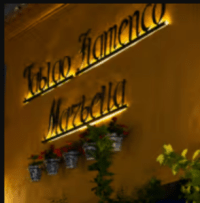EL PININI
by Tony Bryant
Without scripts or structured compositions, the Flamenco artists let themselves be carried away by improvisation and the passion of flamenco. Witness dancing and singing, where the a cappella voice, the guitar chords and the rhythm of the dancers will fill the stage. Dining optional. Tickets for Flamenco Show at Tablao Flamenco in Marbella.
Fernando Peña Soto, El Pinini, was born in Lebrija, Seville, in 1863 and he was the head of one of the biggest and most important flamenco families of the last two hundred years.
El Pinini is an almost mythical character that invented his own personal styles of algerias and cantiñas, which have been continued by other members of this large gypsy clan.
He had nine children, most of who were confident flamenco performers, although none of them professionally.
Many of his children are remembered for their contribution to the art of the cante jondo, but not by their singing or participation, but by the children they produced.
El Pinini`s grandchildren were to become some of the most prestigious artistes in the history of flamenco and they included La Fernanda and La Bernarda de Utrera, Bastían Bacán, Tio Benito and Pepa de Utrera.
Lebrija and Utrera have always had a close connection and it is known that El Pinini lived in both towns during his life. Lebrija is considered one of the foundational centers of the gypsy flamenco and even today Pinini`s legend still lives on in the hearts of its gypsy population.
From the scant information that remains of El Pinini, we can see that he was probably a one-cante specialist although he was said to have performed the bulerias as well as the saetas, during the Easter celebrations in Seville.
He was a slaughterhouse man who worked in the abattoirs in Cadiz, and according to the oral tradition of the gypsies he had a talent that astonished all, including Enrique el Melizo, who heard him sing at a fiesta in Cadiz.
It seems that el Pinini`s life revolved around his family, his wine and his cante and there is a popular verse that tells of his affection for the grape, which is still sung today, especially in Lebrija.
One of El Pinini`s daughters, Fernanda la Vieja was filmed in 1971 for a television documentary about the family of Pinini, and she remembered the old days with affection. Fernanda was eighty-four when the film was shot and in it she said that their house was always full of people and Pinini would come home slightly drunk and a party would start with everyone singing, dancing, or joining in somehow. She said that there would be little bread or food but always plenty of happiness.
Like other performers of this time, no evidence of El Pinini`s cante remains, only the memories of his family members who continue to sing the cantiñas de Pinini. Unfortunately many of the older generation of this family have long since died but there are a few like Miguel el Funi or Inés Bacán who both still reside in Lebrija and who both reproduce the styles of El Pinini.
Is it just gypsy myth and legend that has kept these old singers names held with such esteem or is it possible that these people did actually have such power of song, a kind of spiritual knowledge that has survived to this day?
Many people would opt for the gypsy myth theory but you only have to listen to Inés Bacán, La Bernarda, or Pepa de Utrera to see how they all perform this ancient old style and in no other music has an oral tradition been passed down with such accuracy.
El Pinini died sometime around 1930 although the exact date remains something of a mystery.
Recomended viewing. Rito y Geografia del Cante vol 5. A series of Dvds made between 1970 -`73 by TVE, which shows some of the old greats of flamenco performing in their natural surroundings. This disc has the remaining Pinini clan performing in Lebrija.
